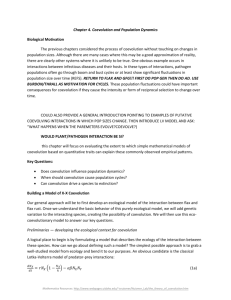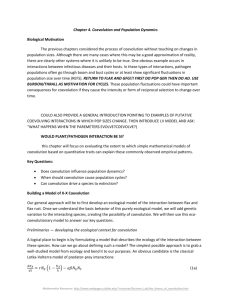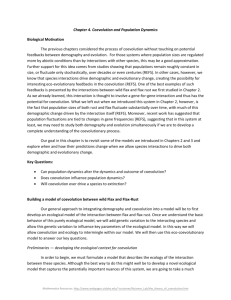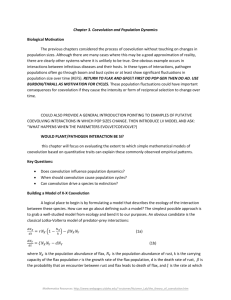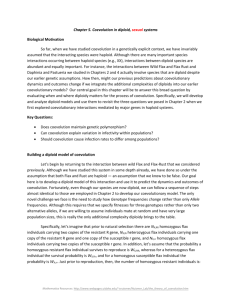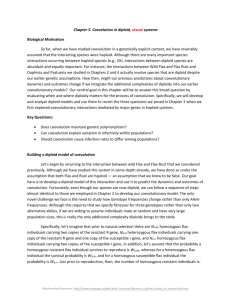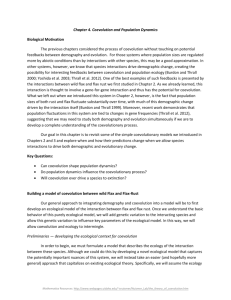Chapter 4. Coevolution and Population Dynamics Biological
advertisement
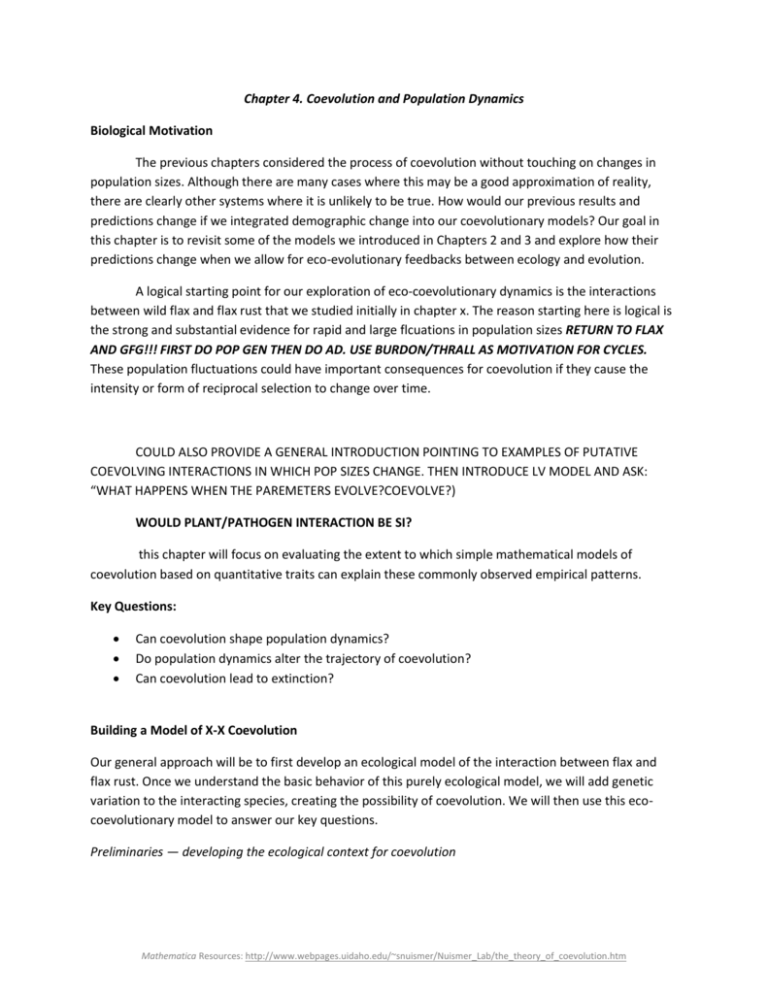
Chapter 4. Coevolution and Population Dynamics Biological Motivation The previous chapters considered the process of coevolution without touching on changes in population sizes. Although there are many cases where this may be a good approximation of reality, there are clearly other systems where it is unlikely to be true. How would our previous results and predictions change if we integrated demographic change into our coevolutionary models? Our goal in this chapter is to revisit some of the models we introduced in Chapters 2 and 3 and explore how their predictions change when we allow for eco-evolutionary feedbacks between ecology and evolution. A logical starting point for our exploration of eco-coevolutionary dynamics is the interactions between wild flax and flax rust that we studied initially in chapter x. The reason starting here is logical is the strong and substantial evidence for rapid and large flcuations in population sizes RETURN TO FLAX AND GFG!!! FIRST DO POP GEN THEN DO AD. USE BURDON/THRALL AS MOTIVATION FOR CYCLES. These population fluctuations could have important consequences for coevolution if they cause the intensity or form of reciprocal selection to change over time. COULD ALSO PROVIDE A GENERAL INTRODUCTION POINTING TO EXAMPLES OF PUTATIVE COEVOLVING INTERACTIONS IN WHICH POP SIZES CHANGE. THEN INTRODUCE LV MODEL AND ASK: “WHAT HAPPENS WHEN THE PAREMETERS EVOLVE?COEVOLVE?) WOULD PLANT/PATHOGEN INTERACTION BE SI? this chapter will focus on evaluating the extent to which simple mathematical models of coevolution based on quantitative traits can explain these commonly observed empirical patterns. Key Questions: Can coevolution shape population dynamics? Do population dynamics alter the trajectory of coevolution? Can coevolution lead to extinction? Building a Model of X-X Coevolution Our general approach will be to first develop an ecological model of the interaction between flax and flax rust. Once we understand the basic behavior of this purely ecological model, we will add genetic variation to the interacting species, creating the possibility of coevolution. We will then use this ecocoevolutionary model to answer our key questions. Preliminaries — developing the ecological context for coevolution Mathematica Resources: http://www.webpages.uidaho.edu/~snuismer/Nuismer_Lab/the_theory_of_coevolution.htm A logical place to begin is by formulating a model that describes the ecology of the interaction between these species. How can we go about defining such a model? The simplest possible approach is to grab a well-studied model from ecology and bend it to our purposes. An obvious candidate is the classical Lotka-Volterra model of predator-prey interactions: 𝑑𝑁𝑋 𝑑𝑡 = 𝑟𝑁𝑋 (1 − 𝑁𝑋 )− 𝑘 𝑑𝑁𝑌 𝑑𝑡 = 𝛼𝜉𝑁𝑋 𝑁𝑌 − 𝑑𝑁𝑌 𝛼𝛽𝑁𝑋 𝑁𝑌 (1a) (1b) DIFFERENTIAL EQUATIONS where 𝑁𝑋 is the population abundance of flax, 𝑁𝑌 is the population abundance of rust, k is the carrying capacity of the flax population r is the growth rate of the flax population, d is the death rate of rust, 𝛽 is the probability that an encounter between rust and flax leads to death of flax, and 𝜉 is the rate at which encounters between flax and rust cause infection and production of new rust individuals (REFS). No doubt, you are now wondering why we would use a classical model of a predator prey interaction for the host-pathogen interaction between flax and flaxrust. What can we learn about the ecological dynamics of this interaction from this simple model? Hopefully, we will be able to answer some simple questions such as whether or not cycles are possible, if there are stable equilibria, and when both of the species are likely to coexist. The simplest way to tackle these questions would be to solve the system of differential equations (1) directly. This would give us a complete solution telling us the abundance of flax and rust at any possible point in time as a function of the model parameters. Unfortunately, however, such a general solution is really not practical. Instead, we will have to satisfy our curiosity by identifying equilibria and assessing their stability. Even though we are now working with differential equations rather than the discrete difference equations we explored in earlier chapters, the procedure for identifying equilibria is identical: simply set the left hand side of the equations equal to zero and solve the resulting system of equations: 0 = 𝑟𝑁𝑋 (1 − 𝑁𝑋 )− 𝑘 𝛼𝛽𝑁𝑋 𝑁𝑌 (2a) 0 = 𝛼𝜉𝑁𝑋 𝑁𝑌 − 𝑑𝑁𝑌 . (2b) Using only relatively simple algebra it is possible to show that there are three possible equilibrium solutions: 𝑁𝑋 = 0 𝑎𝑛𝑑 𝑁𝑌 = 0 (3a) 𝑁𝑋 = 𝑘 𝑎𝑛𝑑 𝑁𝑌 = 0 (3b) 𝑑 𝑁𝑋 = 𝛼𝜉 𝑎𝑛𝑑 𝑁𝑌 = 𝑟(𝛼𝑘𝜉−𝑑) 𝛼 2 𝑘𝜉𝛽 (3c) where the first represents extinction of both species, the second the extinction of the rust only, and the third coexistence of both species. But when, if ever, DOES THE COEXISTENCE EQ EXIST? 2 Only if: 𝛼𝜉𝑘 > 𝑑 (4) will each of these equilibria occur? To answer this question, we must analyze the local stability of these equilibria. Just as we did for the system of discrete time equations describing changes in allele frequencies (chapter 2), the first step is to create a Jacobian Matrix. For the system of ordinary differential equations (2), this Jacobian Matrix is given by: 𝑟− 𝐽=[ 2𝑟𝑁𝑋 𝑘 − 𝛼𝛽𝑁𝑌 𝛼𝜉𝑁𝑌 −𝛼𝛽𝑁𝑋 𝛼𝜉𝑁𝑋 − 𝑑 ]. (5) For the three ecological equilibria (3), the eigenvalues of this Jacobian are: 𝜆1 = 𝑟 𝑎𝑛𝑑 𝜆2 = −𝑑 (6a) 𝜆1 = −𝑟 𝑎𝑛𝑑 𝜆2 = 𝛼𝜉𝑘 − 𝑑 (6b) 𝜆1 = −𝑟𝑑+√𝑟√𝑑√𝑟𝑑+4𝛼𝑑𝑘𝜉−4𝛼2 𝜉 2 𝑘 2 2𝛼𝑘𝜉 𝑎𝑛𝑑 𝜆2 = −𝑟𝑑−√𝑟√𝑑√𝑟𝑑+4𝛼𝑑𝑘𝜉−4𝛼2 𝜉 2 𝑘 2 2𝛼𝑘𝜉 (6c) respectively. Thankfully, we are done with the math for a bit and can now sit back and think about what these results tell us about the ecological dynamics of our interaction. Let’s start with the simplest and most transparent results. First, the equilibrium where both species are extinct is never locally stable because one of its eigenvalues is always positive and real. This makes perfect biological sense since we would imagine that the Flax population would always increase from rarity in the absence of any infection by Flax Rust or intraspecific competition. Second, the equilibrium where only Flax is presence can be locally stable, but only if the rate at which the Flax rust dies, d, exceeds the rate at which it can be produced by infections of a Flax population at its carrying capacity k. So far so good, right? Unfortunately, now we need to spend a bit of time understanding when the third equilibrium is stable, allowing us to identify those conditions that allow Flax and Flax rust to potentially coexist. With those simple results in hand, we can move on to trying to figure out when the third equilibrium is likely to evolve, and what ecological dynamics should be like near this equilibrium. Right off the bat, we can draw one conclusion of biological importance: if the quantity under the more complicated root is negative, the eigenvalues will have an imaginary component and the species abundances will cycle inwards toward the equilibrium. The reason for this is that in continuous time systems, stability is determined by only the real part of the eigenvalue. If the quantity under the more complicated root is negative, the real part of both eigenvalues must be negative because both r and d are positive (Appendix 1; local stability analysis). What if instead, however, the quantity under the more complicated root is positive? In this case, we know that Flax and Flax-Rust populations will not cycle, but whether the equilibrium is stable or not then depends on magnitude of the positive root relative to the product r×d. Together, these considerations and some simple algebra lead to biological predictions for the behavior of the interacting populations (Table 1). Table 1. Summary of stability conditions and ecological dynamics Condition Implications for stability 3 Biological consequences Equilibrium (3c) unstable; Equilibrium (3b) stable Equilibrium (3c) stable; 𝑘 > 𝑑/𝛼𝜉 Equilibrium (3b) unstable Equilibrium (3c) stable and oscillatory; 𝑘 > (𝑑 + √𝑑(𝑑 + 𝑟))⁄2𝛼𝜉 Equilibrium (3b) unstable FIGURE 1 ILLUSTRATES THESE DYNAMICAL REGIMES 𝑘 < 𝑑/𝛼𝜉 Extinction of Rust. Flax at carrying capacity Coexistence of Flax and Rust Coexistence of Flax and Rust. Transient cycles likely. We are now to a point where we can summarize the ecological dynamics of the interaction between Flax and Flax rust in the absence of any coevolution. FIGURE 1. In the next section, we integrate genetic variation for the ecological parameters of our model and investigate how the potential for coevolution impacts the ecology of the interaction. Preliminaries — Integrating coevolution 𝑑𝑁𝑋,𝑅 𝑑𝑡 𝑑𝑁𝑋,𝑟 𝑑𝑡 𝑑𝑁𝑌,𝑉 𝑑𝑡 𝑑𝑁𝑌,𝑣 𝑑𝑡 = 𝑟𝑁𝑋,𝑅 (1 − = 𝑟𝑁𝑋,𝑟 (1 − 𝑁𝑋,𝑅 +𝑁𝑋,𝑟 𝑘 𝑁𝑋,𝑅 +𝑁𝑋,𝑟 𝑘 ) − 𝛼𝑅,𝑉 𝛽𝑁𝑋,𝑅 𝑁𝑌,𝑉 − 𝛼𝑅,𝑣 𝛽𝑁𝑋,𝑅 𝑁𝑌,𝑣 (7a) ) − 𝛼𝑟,𝑉 𝛽𝑁𝑋,𝑟 𝑁𝑌,𝑉 − 𝛼𝑟,𝑣 𝛽𝑁𝑋,𝑟 𝑁𝑌,𝑣 (7b) = 𝛼𝑅,𝑉 𝜉𝑁𝑋,𝑅 𝑁𝑌,𝑉 + 𝛼𝑟,𝑉 𝜉𝑁𝑋,𝑟 𝑁𝑌,𝑉 − 𝑑𝑁𝑌,𝑉 (7c) = 𝛼𝑅,𝑣 𝜉𝑁𝑋,𝑅 𝑁𝑌,𝑣 + 𝛼𝑟,𝑉 𝜉𝑁𝑋,𝑟 𝑁𝑌,𝑣 − 𝑑𝑁𝑌,𝑣 (7d) Analyzing the Model CHANGE OF VARIABLES 1) Define new variables: 𝑁𝑋 = 𝑁𝑋,𝑅 + 𝑁𝑋,𝑟 (8a) 𝑁𝑌 = 𝑁𝑌,𝑉 + 𝑁𝑌,𝑣 (8b) 4 𝑝𝑋 = 𝑁𝑋,𝑅 (8c) 𝑁𝑋,𝑅 +𝑁𝑋,𝑟 𝑝𝑌 = 𝑁 𝑁𝑌,𝑉 (8d) 𝑌,𝑉 +𝑁𝑌,𝑣 2) Apply chain rule: 𝜕𝑁 𝑑𝑁𝑋,𝑅 = 𝜕𝑁 𝑋 𝑑𝑁𝑌 𝑑𝑡 = 𝜕𝑁𝑌 𝑑𝑁𝑌,𝑉 𝜕𝑁𝑌,𝑉 𝑑𝑡 + 𝜕𝑁𝑌 𝑑𝑁𝑌,𝑣 𝜕𝑁𝑌,𝑣 𝑑𝑡 (9b) 𝑑𝑝𝑋 𝑑𝑡 = 𝜕𝑝𝑋 𝑑𝑁𝑋,𝑅 𝜕𝑁𝑋,𝑅 𝑑𝑡 + 𝜕𝑝𝑋 𝑑𝑁𝑋,𝑟 𝜕𝑁𝑋,𝑟 𝑑𝑡 (9c) 𝑑𝑝𝑌 𝑑𝑡 = 𝜕𝑝𝑌 𝑑𝑁𝑌,𝑉 𝜕𝑁𝑌,𝑉 𝑑𝑡 + 𝜕𝑝𝑌 𝑑𝑁𝑌,𝑣 𝜕𝑁𝑌,𝑣 𝑑𝑡 (9d) 𝑑𝑁𝑋 𝑑𝑡 = 𝑟𝑁𝑋 (1 − 𝑑𝑁𝑌 𝑑𝑡 = 𝜉𝑁𝑋 𝑁𝑌 (𝛼̅) − 𝑑𝑁𝑌 (10b) 𝑑𝑝𝑋 𝑑𝑡 = −𝛽𝑁𝑌 𝑝𝑋 𝑞𝑋 (𝑝𝑌 (𝛼𝑅,𝑉 − 𝛼𝑟,𝑉 ) + 𝑞𝑌 (𝛼𝑅,𝑣 − 𝛼𝑟,𝑣 )) (10c) 𝑑𝑝𝑌 𝑑𝑡 = 𝜉𝑁𝑋 𝑝𝑌 𝑞𝑌 (𝑝𝑋 (𝛼𝑅,𝑉 − 𝛼𝑅,𝑣 ) + 𝑞𝑋 (𝛼𝑟,𝑉 − 𝛼𝑟,𝑣 )) (10d) 𝑋,𝑅 𝑑𝑡 𝜕𝑁 𝑑𝑁𝑋,𝑟 𝑑𝑁𝑋 𝑑𝑡 + 𝜕𝑁 𝑋 𝑋,𝑟 𝑁𝑋 )− 𝑘 (9a) 𝑑𝑡 𝛽𝑁𝑋 𝑁𝑌 (𝛼̅) (10a) where 𝛼̅ = 𝛼𝑅,𝑉 𝑝𝑋 𝑝𝑌 + 𝛼𝑅,𝑣 𝑝𝑋 𝑞𝑌 + 𝛼𝑟,𝑉 𝑞𝑋 𝑝𝑌 + 𝛼𝑟,𝑣 𝑞𝑋 𝑞𝑌 and measures the average infectivity of the pathogen population. Re-written in this way, the biology hidden within the equations becomes transparent and we can immediately learn much about the interplay between ecology and evolution. First and foremost, it appears that at least for this particular model of ecology, it is coevolution that drives ecology and not vice versa. Specifically, the only impact of ecology on coevolution is to modulate the rate of coevolutionary change. RELATE COEVOLUTION OF ALPHA BAR TO TABLE 1 CONDITIONS FOR THE SPECIFIC CASE OF THE GFG MODEL: 𝑑𝑁𝑋 𝑑𝑡 = 𝑟𝑁𝑋 (1 − 𝑁𝑋 )− 𝑘 𝑑𝑁𝑌 𝑑𝑡 = 𝜉𝑁𝑋 𝑁𝑌 (𝛼̅) − 𝑑𝑁𝑌 (11b) 𝑑𝑝𝑋 𝑑𝑡 = 𝛽𝑁𝑌 𝑝𝑋 𝑞𝑋 𝑞𝑌 (11c) 𝛽𝑁𝑋 𝑁𝑌 (𝛼̅) (11a) 5 𝑑𝑝𝑌 𝑑𝑡 = 𝜉𝑁𝑋 𝑝𝑌 𝑞𝑌 𝑝𝑋 (11d) where for the GFG mode, 𝛼̅ = 1 − 𝑝𝑋 𝑞𝑌 . OK, so the cool thing is this: look back at chapter two where we modeled coevolution without including any explicit ecology. How cool is that? Exact same equations but modified by the population size of the opposing species! This leads us to make a few logical guesses about the behavior of our coevolving system. Specifically, we would expect both the evolutionary and ecological dynamics to be identical to what they were in isolation. Although this logic seems compelling, let’s take a more formal approach to make sure our intuition is correct. SO COEVOLUTION HAS NO REAL IMPACT ON EQUILIBRIA OR STABILITY OF ECOLOGY. BUT WHAT ABOUT ITS TRANSIENT IMPACTS? SURELY THE SPREAD OF THE VIRULENT ALLELE MUST IMPACT DEMOGRAPHY? WE EXPLORE THIS NUMERICALLY. THIS IS A BIT OF A FARSE, BECAUSE I SET THE ORIGINAL ECOLOGICAL MODEL UP AS THE END STATE OF COEVOLUTION. THUS, THE RESULTS WERE pre-ordained. IF I STARTED THE MODEL WITH THE ORIGINAL ECOLOGICAL MODEL SET AT pa=pb=0 rather than pa=pb=1, I would see a large impact of coevolution… ALPHA BAR ALWAYS EVOLVES to ONE SO WE ALWAYS EVOLVE TO THE ORIGINAL ECOLOGICAL MODEL. BUT WHAT HAPPENS ALONG THE WAY? Answers to Key Questions: Can coevolution shape population dynamics? Yes. Do population dynamics alter the trajectory of coevolution? No. Population dynamics modulate only the rate of coevolution, not its trajectory. Can coevolution lead to extinction? No. New Questions Arising: . At the same time, however, our model analyses raise several important questions: Does the inclusion of costs amplify the interplay between coevolution and ecology? Are these results general or specific to gene for gene interactions? In the next three sections, we will develop generalizations of our simple model which allow us to answer these questions and gain further insight into the process of coevolution mediated by quantitative traits. Generalizations 6 Generalization 1: Does the inclusion of costs amplify the interplay between coevolution and ecology? We know costs can strongly influence the dynamics of gene-for-gene coevolution, allowing for cycles. It also seems likely that costs could increase the scope for feedbacks between ecology and evolution because the benefits of resistance and virulence depend on the abundance of pathogens and hosts whereas the costs of resistance and virulence are static. Thus, we might expect interesting feedbacks to be present with costs that we did not identify when costs were absent. 𝑑𝑁𝑋,𝑅 𝑑𝑡 𝑑𝑁𝑋,𝑟 𝑑𝑡 𝑑𝑁𝑌,𝑉 𝑑𝑡 𝑑𝑁𝑌,𝑣 𝑑𝑡 = 𝑟𝑅 𝑁𝑋,𝑅 (1 − = 𝑟𝑟 𝑁𝑋,𝑟 (1 − 𝑁𝑋,𝑅 +𝑁𝑋,𝑟 𝑘 𝑁𝑋,𝑅 +𝑁𝑋,𝑟 𝑘 ) − 𝛼𝑅,𝑉 𝛽𝑁𝑋,𝑅 𝑁𝑌,𝑉 − 𝛼𝑅,𝑣 𝛽𝑁𝑋,𝑅 𝑁𝑌,𝑣 ) − 𝛼𝑟,𝑉 𝛽𝑁𝑋,𝑟 𝑁𝑌,𝑉 − 𝛼𝑟,𝑣 𝛽𝑁𝑋,𝑟 𝑁𝑌,𝑣 (12a) (12b) = 𝛼𝑅,𝑉 𝜉𝑁𝑋,𝑅 𝑁𝑌,𝑉 + 𝛼𝑟,𝑉 𝜉𝑁𝑋,𝑟 𝑁𝑌,𝑉 − 𝑑𝑉 𝑁𝑌,𝑉 (12c) = 𝛼𝑅,𝑣 𝜉𝑁𝑋,𝑅 𝑁𝑌,𝑣 + 𝛼𝑟,𝑉 𝜉𝑁𝑋,𝑟 𝑁𝑌,𝑣 − 𝑑𝑣 𝑁𝑌,𝑣 (12d) 𝑑𝑁𝑋 𝑑𝑡 = 𝑟̅ 𝑁𝑋 (1 − 𝑁𝑋 )− 𝑘 𝑑𝑁𝑌 𝑑𝑡 = 𝛼̅𝜉𝑁𝑋 𝑁𝑌 − 𝑑̅𝑁𝑌 𝑑𝑝𝑋 𝑑𝑡 = 𝑝𝑋 𝑞𝑋 (𝛽𝑁𝑌 𝑞𝑌 − 𝜏𝑅 (1 − 𝑑𝑝𝑌 𝑑𝑡 = 𝑝𝑌 𝑞𝑌 (𝜉𝑁𝑋 𝑝𝑋 − 𝜏𝑉 ) 𝛼̅𝛽𝑁𝑋 𝑁𝑌 (13a) (13b) 𝑁𝑋 )) 𝑘 (13c) (13d) where 𝛼̅ = 1 − 𝑝𝑋 𝑞𝑌 , 𝑟̅ = 𝑟𝑅 𝑝𝑋 + 𝑟𝑟 𝑞𝑋 , 𝑑̅ = 𝑑𝑉 𝑝𝑌 + 𝑑𝑣 𝑞𝑌 , 𝜏𝑅 = 𝑟𝑟 − 𝑟𝑅 , 𝜏𝑉 = 𝑑𝑉 − 𝑑𝑣 Generalization #2: Other forms of genetic interaction A return to Daphnia, pasteuria, and Matching alleles 𝑑𝑁𝑋 𝑑𝑡 = 𝑟𝑁𝑋 (1 − 𝑁𝑋 )− 𝑘 𝑑𝑁𝑌 𝑑𝑡 = 𝜉𝑁𝑋 𝑁𝑌 (𝛼̅) − 𝑑𝑁𝑌 𝛽𝑁𝑋 𝑁𝑌 (𝛼̅) (14a) (14b) 7 𝑑𝑝𝑋 𝑑𝑡 = 𝛽𝑁𝑌 𝑝𝑋 𝑞𝑋 (1 − 2𝑝𝑌 ) (14c) 𝑑𝑝𝑌 𝑑𝑡 = −𝜉𝑁𝑋 𝑝𝑌 𝑞𝑌 (1 − 2𝑝𝑋 ) (14d) where 𝛼̅ = 𝑝𝑋 𝑝𝑌 + 𝑞𝑋 𝑞𝑌 HERE WE SEE THAT COEVOLUTION INFLUENCES ECOLOGY, BUT NOT VICE VERSA Generalization #3: Quantitative traits A return to cuckoos and their hosts and an introduction to adaptive dynamics 𝑑𝑁𝑋 𝑑𝑡 = 𝑟𝑁𝑋 (1 − 𝑁𝑋 )− 𝑘 𝑑𝑁𝑌 𝑑𝑡 = 𝜉𝛼(𝑥, 𝑦)𝑁𝑋 𝑁𝑌 − 𝑑𝑁𝑌 𝛽𝛼(𝑥, 𝑦)𝑁𝑋 𝑁𝑌 (15a) (15b) Specify alpha: 𝑑𝑁𝑋 𝑑𝑡 = 𝑟𝑁𝑋 (1 − 𝑁𝑋 )− 𝑘 𝑑𝑁𝑌 𝑑𝑡 = 𝜉𝐸𝑥𝑝[−𝛼(𝑥 − 𝑦)2 ]𝑁𝑋 𝑁𝑌 − 𝑑𝑁𝑌 𝛽𝐸𝑥𝑝[−𝛼(𝑥 − 𝑦)2 ]𝑁𝑋 𝑁𝑌 (16a) (16b) Find ecological equilibra: ̂𝑋 = 0 𝑎𝑛𝑑 𝑁 ̂𝑌 = 0 𝑁 (17a) ̂𝑋 = 𝑘 𝑎𝑛𝑑 𝑁 ̂𝑌 = 0 𝑁 (17b) ̂𝑋 = 𝑁 𝑑 𝐸𝑥𝑝[−𝛼(𝑥−𝑦)2 ]𝜉 ̂𝑌 = 𝑟(𝑘𝜉𝐸𝑥𝑝[−𝛼(𝑥−𝑦) 𝑎𝑛𝑑 𝑁 2 ]−𝑑) 𝑘𝜉𝛽(𝐸𝑥𝑝[−𝛼(𝑥−𝑦)2 ]2 ) Find “invasion fitness” 𝜕 𝑑𝑁𝑋 𝑑𝑡 = 2𝛼𝛽𝜇 ⅇ −(𝑥−𝑦)2 𝛼 (𝑥 − 𝑦)𝑁 ̂𝑋 𝑁 ̂𝑌 𝑋 𝜕𝑥 8 (17c) 𝜕 𝑑𝑁𝑌 𝑑𝑡 = 2𝛼𝜉𝜇 ⅇ −(𝑥−𝑦)2 𝛼 (𝑥 − 𝑦)𝑁 ̂𝑋 𝑁 ̂𝑌 𝑌 𝜕𝑦 And evaluate these at the ecological equilibrium of interest… Let’s focus on 17c where both species coexist… 𝜕 𝜕 𝑑𝑁𝑋 2 (𝑥−𝑦)2 𝛼 𝑟(𝑥 − 𝑦)𝛼(−𝑑ⅇ (𝑥−𝑦) 𝛼 + 𝑘𝜉)𝜇𝑋 𝑑𝑡 = 2𝑑ⅇ 𝜕𝑥 𝑘𝜉 2 𝑑𝑁𝑌 2 (𝑥−𝑦)2 𝛼 𝑟(𝑥 − 𝑦)𝛼(−𝑑ⅇ (𝑥−𝑦) 𝛼 + 𝑘𝜉)𝜇𝑌 𝑑𝑡 = 2𝑑ⅇ 𝜕𝑦 𝑘𝛽𝜉 OK. So what can we learn from these invasion thingers? Maybe we could identify coevolutionary equilibra? 𝑦=𝑥 𝑘𝜉 𝑥√𝛼 − √Log[ ] 𝑑 𝑦= √𝛼 𝑘𝜉 𝑥√𝛼 + √Log[ ] 𝑑 𝑦= √𝛼 Let’s focus on the first and ask whether it is CONVERGENT, or locally stable to normal people. To do this, we must Conclusions and Synthesis 9 References Figure Legends 10

